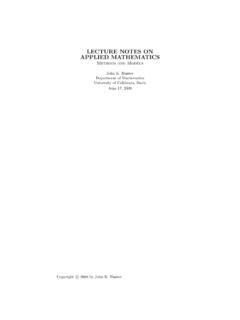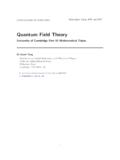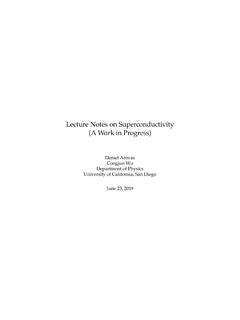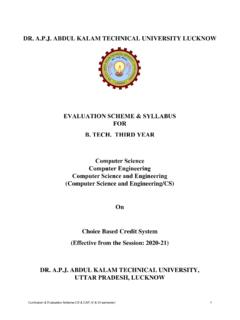Transcription of Quantum Physics II, Lecture Notes 5 - MIT OpenCourseWare
1 UNCERTAINTY PRINCIPLE AND COMPATIBLE OBSERVABLES B. Zwiebach October 21, 2013 Contents 1 Uncertainty defined 1 2 The Uncertainty Principle 3 3 The Energy-Time uncertainty 6 4 Lower bounds for ground state energies 9 5 Diagonalization of Operators 11 6 The Spectral Theorem 12 7 Simultaneous Diagonalization of Hermitian Operators 16 8 Complete Set of Commuting Observables 18 1 Uncertainty defined As we know, observables are associated to Hermitian operators. Given one such operator A we can use it to measure some property of the physical system , as represented by a state . If the state is in an eigenstate of the operator A, we have no uncertainty in the value of the observable, which coincides with the eigenvalue corresponding to the eigenstate.
2 We only have uncertainty in the value of the observable if the physical state is not an eigenstate of A, but rather a superposition of various eigenstates with different eigenvalues. We want to define the uncertainty A( ) of the Hermitian operator A on the state . This uncertainty should vanish if and only if the state is an eigenstate of A. The uncertainty, moreover, should be a real number. In order to define such uncertainty we first recall that the expectation value of A on the state , assumed to be normalized, is given by (A) = ( |A| ) = ( , A ). ( ) The expectation (A)is guaranteed to be real since A is Hermitian. We then define the uncertainty as the norm of the vector obtained by acting with (A (A)I) on the physical state (I is the identity operator): A( ) A (A)I.
3 ( ) 1 The uncertainty, so defined is manifestly non-negative. If the uncertainty is zero, the vector inside the norm is zero and therefore: A( ) = 0 A (A)I = 0 A = (A) , ( ) and the last equation confirms that the state is indeed an eigenstate of A (note that(A)is a number). You should also note that (A)is indeed the eigenvalue, since taking the eigenvalue equation A = and forming the inner product with another we get ( , A )= ( , )= = (A). ( ) Alternatively, if the state is an eigenstate, we now now that the eigenvalue if (A)and therefore the state (A (A)I) vanishes and its norm is zero. We have therefore shown that The uncertainty A( ) vanishes if and only if is an eigenstate of A.
4 ( ) To compute the uncertainty one usually squares the expression in ( ) so that \( A( ))2 = A (A)I , A (A)I ) ( ) Since the operator A is assumed to be Hermitian and consequently (A)is real, we have (A (A)I) = A (A)I, and therefore we can move the operator on the first entry onto the second one to find \2( A( ))2 = , A (A)I ). ( ) While this is a reasonable form, we can simplify it further by expansion \( A( ))2 = , A2 2(A)A+ (A)2I ). ( ) The last two term combine and we find ( A( ))2 = (A2) (A)2 . ( ) Since the left-hand side is greater than or equal to zero, this incidentally shows that the expectation value of A2 is larger than the expectation value of A, squared: (A2) (A)2 . ( ) An interesting geometrical interpretation of the uncertainty goes as follows.
5 Consider the one-dimensional vector subspace U generated by . Take the state A and project it to the subspace U . The projection, we claim is (A) and the part of A in the orthogonal subspace U is a vector of norm equal to the uncertainty A. Indeed the orthogonal projector PU is PU = | )( |, ( ) 2 2 Figure 1: A state and the one-dimensional subspace U generated by it. The projection of A to U is (A) . The orthogonal complement is a vector whose norm is the uncertainty A( ). so that PU A| )= | )( |A| )= | )(A). ( ) Moreover, the vector A| )minus its projection must be a vector | )orthogonal to | ) A| ) (A)| )= | ), ( ) as is easily confirmed by taking the overlap with the bra . Since the norm of the above left-hand side is the uncertainty, we confirm that A = | |, as claimed.
6 These results are illustrated in Figure 1. The Uncertainty Principle The uncertainty principle is an inequality that is satisfied by the product of the uncertainties of two Hermitian operators that fail to commute. Since the uncertainty of an operator on any given physical state is a number greater than or equal to zero, the product of uncertainties is also a real number greater than or equal to zero. The uncertainty inequality often gives us a lower bound for this product. When the two operators in question commute, the uncertainty inequality gives no information. Let us state the uncertainty inequality. Consider two Hermitian operators A and B and a physical state of the Quantum system . Let A and B denote the uncertainties of A and B, respectively, in the state.
7 Then we have \1 2 ( A)2( B)2 | [A, B] . ( ) 2iThe left hand side is a real, non-negative number. For this to be consistent inequality, the right-hand side must also be a real number that is not negative. Since the right-hand side appears squared, the object inside the parenthesis must be real. This can only happen for all if the operator 1 [A, B] ( ) 2i3 is Hermitian. For this first note that the commutator of two Hermitian operators is anti-Hermitian: [A, B] = (AB) (BA) = B A A B BA = [A, B] ( ) The presence of theithen makes the operator in ( ) Hermitian. Note that the uncertainty inequality can also be written as 1\ A B | [A, B] . ( ) 2iwhere the bars on the right-hand side denote absolute value.
8 Before we prove the theorem, let s do the canonical example! Substuting x for A and p for B results in the position-momentum uncertainty relation you have certainly worked with: 1 2 ( x)2( p)2 ( | [ x, p ]| ) . ( ) 2iSince [ x, p ]/(2i) = 1/2 we get 12 ( x)2( p)2 x p 1 . ( ) 42 We are interested in the proof of the uncertainty inequality for it gives the information that is needed to find the conditions that lead to saturation. Proof. We define the following two states: |f) (A (A)I)| ) ( ) |g) (B (B)I)| ). Note that by the definition ( ) of uncertainty, (f|f)= ( A)2 , ( ) (g|g)= ( B)2 . The Schwarz inequality immediately furnishes us an inequality involving precisely the uncertainties (f|f)(g|g) |(f|g)|2 , ( ) and therefore we have ( A)2( B)2 |(f|g)|2 = (Re(f|g))2 + (Im(f|g))2.
9 ( ) Writing A = (A (A)I) and B = (B (B)I), we now begin to compute the right-hand side: (f|g)= ( |A B | )= ( |(A (A)I)(B (B)I)| )= ( |AB| ) (A)(B), ( ) and since |f)and |g)go into each other as we exchange A and B, (g|f)= ( |A B | )= ( |BA| ) (B)(A). ( ) 4 [ [ From the two equations above we find a nice expression for the imaginary part of (f|g): 11 Im(f|g)= ((f|g) (g|f)) = ( |[A, B]| ). ( ) 2i2iFor the real part the expression is not that simple, so it is best to leave it as the anticommutator of the checked operators: Re(f|g)= 1 ((f|g)+ (g|f)) = 1 ( |{ A, B}| ) ( ) 22 Back in ( ) we get ( A)2( B)2 ( | 1 [A, B]| ) 2 + ( | 1 { A, B}| ) 2 . ( ) 2i2 This can be viewed as the most complete form of the uncertainty inequality.]]
10 It turns out, however, that the second term on the right hand side is seldom simple enough to be of use, and many times it can be made equal to zero for certain states. At any rate, the term is positive or zero so it can be dropped while preserving the inequality. This is often done, thus giving the celebrated form ( ) that we have now established. Now that we have a proven the uncertainty inequality, we can ask: What are the conditions for this inequality to be saturated? If the goal is to minimize uncertainties, under what conditions can we achieve the minimum possible product of uncertainties? As the proof shows, saturation is achieved under two conditions: 1. The Schwarz inequality is saturated.















